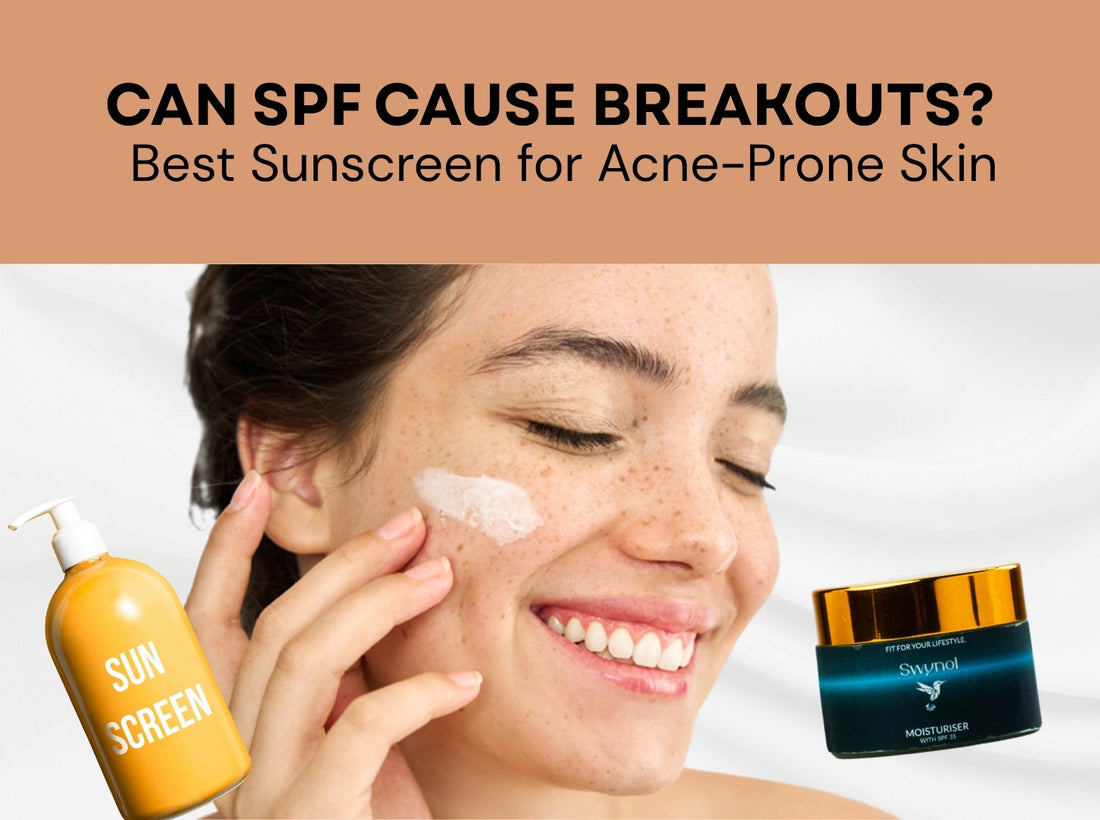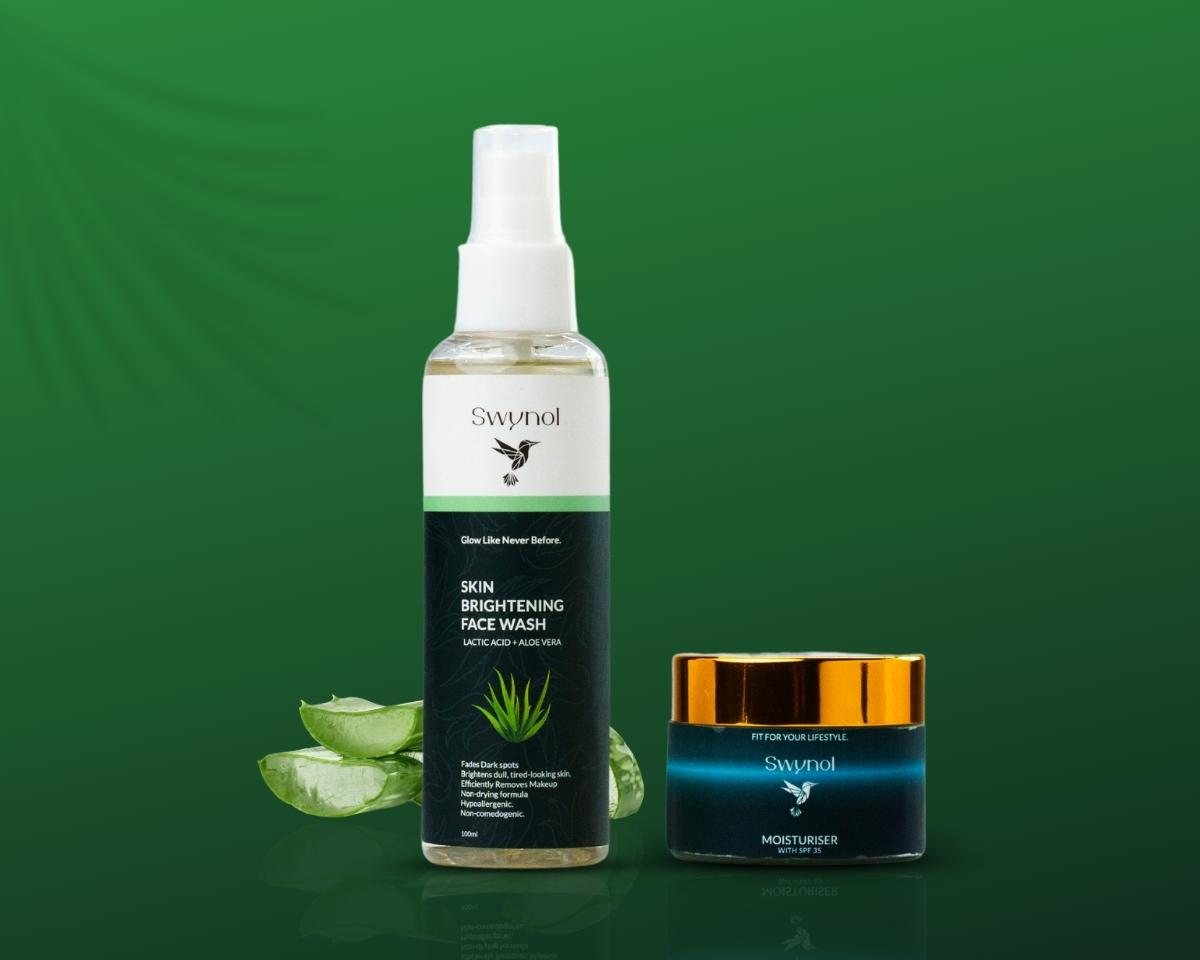Can SPF Cause Breakouts? Best Sunscreen for Acne-Prone Skin

Share
Can Sunscreen Really Cause Breakouts? Discover the Best Non-Comedogenic SPF for Acne-Prone Skin
Can Sunscreen Really Trigger Breakouts? Here’s the Truth
Sunscreen is a non-negotiable in any skincare routine—but for many with oily, sensitive, or acne-prone skin, applying SPF can lead to a different kind of skin emergency: breakouts, clogged pores, and excess shine. If you’ve ever felt like sunscreen makes your acne worse, you’re not alone.
But here’s the key: not all sunscreens are created equal. The culprit behind SPF-induced acne is often comedogenic ingredients—like heavy oils, waxes, or certain silicones—that trap sweat, oil, and debris in your pores, especially in humid summer climates.
At Swynol, we’ve made it our mission to create acne-safe, dermatologist-backed skincare that delivers UV protection without pore congestion. Whether you’re dealing with blackheads, whiteheads, or occasional flare-ups, choosing the right sunscreen can make or break your skin health.
This guide breaks down why some sunscreens cause breakouts, how to choose the best non-comedogenic SPF, and which Swynol products are summer must-haves for clear, protected skin.
Does Wearing Sunscreen Cause Acne?
Short Answer: Yes—it can, but only if you’re using the wrong kind.
If your sunscreen feels greasy, leads to congested skin, or worsens acne over time, it may contain ingredients that clog pores and trap oil. This is especially common in oily skin types or during summer, when sweat and humidity are already overwhelming your skin’s balance.
The good news? There are plenty of lightweight, non-comedogenic sunscreens that protect your skin without causing breakouts.
How Can You Tell If Your Sunscreen Is Causing Breakouts?
Here are a few telltale signs your SPF might be behind your skin issues:
-
Does your skin feel greasy, sticky, or heavy after applying SPF?
-
Do you notice whiteheads, blackheads, or small bumps the next day?
-
Are you using a generic sunscreen not formulated for your skin type?
If so, it’s time to make the switch to a non-comedogenic, oil-free sunscreen.
What Makes a Sunscreen Non-Comedogenic?
To protect your skin without triggering acne, check for these features:
Non-Comedogenic – Won’t block pores or cause breakouts
Oil-Free or Water-Based – Lightweight and breathable on the skin
Broad Spectrum SPF 30+ – Shields against UVA & UVB rays
Matte or Gel Finish – Ideal for oily or acne-prone skin types
Fragrance-Free or Hypoallergenic – Prevents irritation and flare-ups
Choosing the right SPF isn't just about UV protection—it’s about preserving your skin’s clarity and comfort all day long.
Swynol Moisturizer with SPF 35: The Best SPF for Acne-Prone Skin
Looking for an acne-safe, lightweight SPF you can wear daily without breakouts? Meet your new summer essential — Swynol Moisturizer with SPF 35.
Why You’ll Love It:
-
Non-Comedogenic & Dermatologist-Tested – Safe for acne-prone, oily, and sensitive skin
-
Broad Spectrum Protection – Shields skin from UVA & UVB damage
-
Lightweight & Hydrating – Moisturizes without shine or heaviness
-
Matte Finish – Perfect for no-makeup days or under foundation
-
Enriched with Soothing Actives – Helps calm inflammation and support skin balance
This dual-action moisturizer + sunscreen simplifies your routine and keeps your skin clear, protected, and comfortable, even in hot, humid weather.
How to Prevent Breakouts While Using Sunscreen
Even the best SPF can lead to breakouts if not used with the right routine. Here’s how to stay protected without clogging your pores:
1. Start With Clean Skin
Use Swynol’s Aloe Vera & Lactic Acid Facewash to remove dirt, oil, and dead skin before applying SPF. This prevents sunscreen from mixing with impurities and blocking pores.
2. Reapply Without Residue
Blot sweat and oil before reapplying SPF every 2 hours when outdoors. Avoid layering SPF over greasy or sweaty skin.
3. Double Cleanse at Night
Sunscreen + sweat = build-up. Use a gentle oil cleanser followed by a foaming facewash to remove SPF completely and prevent congestion.
4. Use Targeted Serums
Apply Swynol’s Niacinamide + Zinc Serum daily to minimize oil production, reduce inflammation, and refine pores.
Why Skipping Sunscreen Is a Bad Idea (Even If You Have Acne)
You might be tempted to ditch sunscreen altogether—but that’s the worst thing you can do if you have acne.
Sun exposure darkens post-acne marks, making them last longer.
It increases inflammation, which can worsen active breakouts.
Many acne treatments like retinol and exfoliating acids make your skin more UV-sensitive—SPF is critical.
Instead of skipping SPF, switch to one that’s designed for acne-prone skin—like Swynol’s.
Swynol’s Top Skincare Picks for Oily & Acne-Prone Skin
Swynol Moisturizer with SPF 35 – Non-comedogenic hydration + UV defense
Aloe Vera & Lactic Acid Facewash – Deep cleanse without stripping skin
Niacinamide + Zinc Serum – Balances oil and soothes breakouts
Pure Hyaluronic Acid Serum – Light, non-greasy moisture
Skin Lightening Serum – Reduces acne marks and evens skin tone
Pair these together for a complete acne-safe summer skincare routine that protects, heals, and hydrates.
Final Thoughts: Don’t Blame SPF—Blame the Wrong Formula
So, does sunscreen cause breakouts? Only if you’re using one that clogs pores or overwhelms your skin.
With Swynol’s SPF 35 Moisturizer, you don’t have to choose between sun protection and clear skin. You can have both—breakout-free, shine-free confidence all summer long.
Remember, skincare isn’t about skipping steps. It’s about choosing the right ones.
Frequently Asked Questions (FAQ)
Q1. What SPF is best for oily skin prone to acne?
Look for SPF 30 or higher, non-comedogenic, oil-free, and matte-finish formulas like Swynol’s SPF 35 Moisturizer.
Q2. Can sunscreen make acne worse?
Yes, if it contains pore-clogging oils or comedogenic ingredients. Always opt for acne-safe sunscreens.
Q3. Is moisturizer with SPF enough for daily protection?
Yes—if it offers broad spectrum SPF 30+ and is reapplied as needed.
Q4. How often should I reapply sunscreen if I have oily skin?
Every 2 hours during sun exposure. Blot oil first to avoid layering over sweat.
Q5. Can I wear SPF under makeup?
Absolutely. Swynol’s matte-finish SPF 35 layers beautifully under makeup and controls shine.


